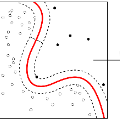With the increase in the learning capability of deep convolution-based architectures, various applications of such models have been proposed over time. In the field of anomaly detection, improvements in deep learning opened new prospects of exploration for the researchers whom tried to automate the labor-intensive features of data collection. First, in terms of data collection, it is impossible to anticipate all the anomalies that might exist in a given environment. Second, assuming we limit the possibilities of anomalies, it will still be hard to record all these scenarios for the sake of training a model. Third, even if we manage to record a significant amount of abnormal data, it's laborious to annotate this data on pixel or even frame level. Various approaches address the problem by proposing one-class classification using generative models trained on only normal data. In such methods, only the normal data is used, which is abundantly available and doesn't require significant human input. However, these are trained with only normal data and at the test time, given abnormal data as input, may often generate normal-looking output. This happens due to the hallucination characteristic of generative models. Next, these systems are designed to not use abnormal examples during the training. In this paper, we propose anomaly detection with negative learning (ADNL), which employs the negative learning concept for the enhancement of anomaly detection by utilizing a very small number of labeled anomaly data as compared with the normal data during training. The idea is to limit the reconstruction capability of a generative model using the given a small amount of anomaly examples. This way, the network not only learns to reconstruct normal data but also encloses the normal distribution far from the possible distribution of anomalies.
翻译:随着深层混凝土建筑的学习能力的提高,这些模型的各种应用随着时间推移而提出。在异常点探测领域,深度学习的改进为试图使数据收集劳动密集型特征自动化的研究人员开辟了新的探索前景。首先,在数据收集方面,不可能预测在特定环境中可能存在的所有异常点。第二,假设我们限制异常的可能性,为了培训模型,仍然很难记录所有这些假设情景。第三,即使我们设法记录大量异常数据,在异常点网络甚至框架水平上注意到这种数据也很费劲。各种办法解决了问题,利用只受过正常数据培训的基因化模型来提出单级分类。在这种方法中,只使用正常数据,而这种数据是完全存在的,并不需要大量的人类投入。然而,这些只是用正常数据来记录,在测试时间里,由于输入的异常数据往往产生正常值,这要归功于基因化模型的错觉化特征。接下来,这些系统通过使用典型的分类模型来解决这个问题, 使用正常值的正常值的正常度分析方法, 并且用反常态的变的变的变的变的变的变的变的变的变的变的模型来学习数据。





